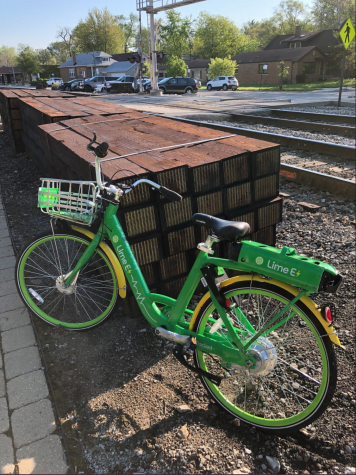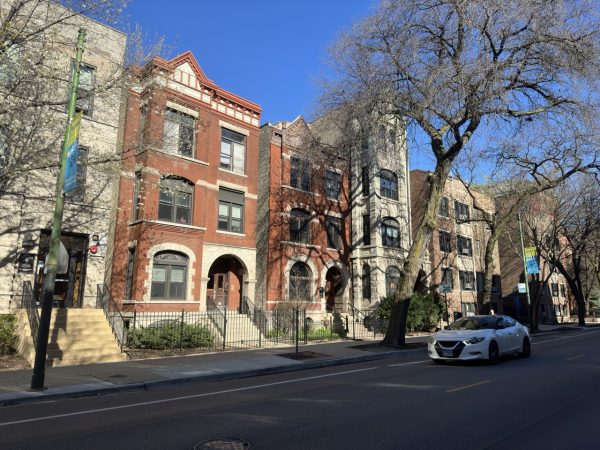Chicago’s South Side serving freshly-squeezed LimeBikes
People riding LimeBikes past a rusted plant in Seattle, Washington. Seattle is one of many cities in U.S. who adopted dockless bike sharing.
Streaming along the street atop a light blue Divvy bike, senior hospitality management student Jacob Jandacek anxiously searches for the docking station — the past three docks have been completely filled, and his time is running out.
Jandacek says that while finding only filled docking stations is not an extremely common occurrence, it does happen for him in about one out of ten rides, and it can be extremely annoying or problematic.
“I usually haven’t had more than a five minute walk to find a Divvy station,” Jandacek said. “I’ve had it happen though, and it’s a pain when it happens.”
Jandacek says that using Divvy has helped to alleviate some worries surrounding biking for him.
“I don’t have to worry about my bike getting stolen, and if I’m running late I can just hop on one, and I don’t have to worry about traffic or anything like that,” Jandacek says.
The annoyance of finding a convenient, close, and empty dock is a problem a new dockless bike sharing company, LimeBike, hopes to solve. Cyclists can simply find a LimeBike, open an app to scan a QR code and then unlock the bike. Once their ride is finished, a user can just end their trip and leave the bike wherever they want.
LimeBike has already launched their fleet of bikes in cities across the country and in Europe, and they have begun testing out Chicago as a new destination city. Currently, LimeBikes can only be found scattered around the 19th ward in the South Side, including the neighborhoods Morgan Park and Beverly. LimeBike will also start introducing electronically assisted bikes to Chicago as well.
“You can pedal really lightly and easily like you’re in a low gear, but suddenly you’re going 15mph,” Jandacek said. “A lot of old people use them in Italy to get around. I could see it being extremely useful for commutes. If I had access to electric assist bikes, I probably would use those instead of public transit to get to school and work.”
Erik Landfried lives in Durham, North Carolina, one of the cities where LimeBike has been established. He works for GOTriangle, a public transportation provider which serves North Carolina’s “Triangle”: Durham, Raleigh and Chapel Hill.
“They came back in November of last year. Both my wife and I started using it right away,” Landfried said. “(My wife) didn’t do a lot of biking before the bike share came, but she’s doing it a lot more. She often takes the bus to work, so when she comes back, the transit station is about a mile and a half from our house. Instead of walking home she can grab a bike and get home faster.”
Landfried says the convenience of the dockless bikes has gotten many people biking who may not have done so before.
“You can pretty much count that there will be a bike where you are going now. So if you were going to walk or drive somewhere and you see a bike you can use, you might be more likely to grab that,” Landfried said.

Some LimeBikes have begun showing signs of wear with users carelessly discarding bikes.
According to Landfried, another downside to the docking model beyond filled stations is that docking stations are sometimes placed in dangerous areas. Landfried says once he had to cross a busy street to put his bike in a docking station across from his destination.
That’s why Lanfried says docking stations work better in large cities – and why they wouldn’t be feasible in sprawling locales like Durham.
There are also downsides to the dockless system, however. As users can leave the LimeBikes anywhere, some may leave them in inconvenient areas.
“They get tipped over a lot and some people are leaving them in inappropriate places like the sidewalk or blocking a business entrance,” Landfried said. “I’ve never called one in because I’ll just move it off to the side. The dockless bikes are very light so you can just lift it up and move it. I see just as many cars parked on the sidewalks in Durham as dockless bikes, which I think is a worse problem.”
21-year-old musician and Durham resident Parker Harris says his experience with LimeBike has overall been negative.
“I just don’t like the way they feel, and they get more and more dinged up every time I use them because they’re constantly outside and being abused by humans,” Harris said.
Harris also takes issue with what he says is LimeBikes’ shoddy construction.
“As a cyclist with a stolen bike I benefit from the Limes, but I don’t trust them for more than like a mile at a time,” Harris said. “I’ve ridden them and had them be incredibly shaky or the chain keeps catching, which is terrifying to be honest.”
While Jandacek says he’s willing to try out the new LimeBikes, he is concerned about how evenly placed around some neighborhoods they will be, and he ultimately thinks that Divvy caters to a different audience than LimeBike.
“The locations of dockless bikes are likely very random and sparse in unpopulated neighborhoods, which is a turn off to the Divvy customer base — we know where our bikes are going to be,” Jandecek said.
Jandacek says he won’t be giving up Divvy bike pass anytime soon, which allows him to check out any Divvy bike for an annual price of $99.
“It’s very convenient to make my commute easier,” he said. “It’s also just nice to take a bike ride by the lake when it’s nice out. I’ll try the dockless approach when it’s more widely available, especially if they have electric assist bikes.”












